Summary: in this tutorial, you will learn how to use the Oracle GROUP BY clause to group rows into groups.
Introduction to Oracle GROUP BY clause
The GROUP BY clause is used in a SELECT statement to group rows into a set of summary rows by values of columns or expressions. The GROUP BY clause returns one row per group.
The GROUP BY clause is often used with aggregate functions such as AVG(), COUNT(), MAX(), MIN() and SUM(). In this case, the aggregate function returns the summary information per group. For example, given groups of products in several categories, the AVG() function returns the average price of products in each category.
The following illustrates the syntax of the Oracle GROUP BY clause:
SELECT
column_list
FROM
T
GROUP BY c1,c2,c3;
Code language: SQL (Structured Query Language) (sql)The GROUP BY clause appears after the FROM clause. In case WHERE clause is presented, the GROUP BY clause must be placed after the WHERE clause as shown in the following query:
SELECT
column_list
FROM
T
WHERE
condition
GROUP BY c1, c2, c3;Code language: SQL (Structured Query Language) (sql)The GROUP BY clause groups rows by values in the grouping columns such as c1, c2 and c3. The GROUP BY clause must contain only aggregates or grouping columns.
If you want to specify multiple levels of grouping that should be computed at once, you use the following ROLLUP syntax:
SELECT
column_list
FROM
T
GROUP BY
ROLLUP(c1,c2,c3);
Code language: SQL (Structured Query Language) (sql)Please check out the ROLLUP tutorial for more information.
Oracle GROUP BY examples
We will use the following orders and order_items in the sample database for the demonstration:
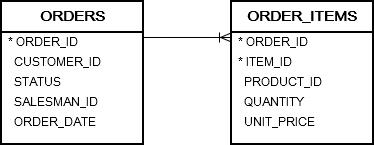
A) Oracle GROUP BY basic example
The following statement uses the GROUP BY clause to find unique order statuses from the orders table:
SELECT
status
FROM
orders
GROUP BY
status;
Code language: SQL (Structured Query Language) (sql)
This statement has the same effect as the following statement which uses the DISTINCT operator:
SELECT
DISTINCT status
FROM
orders;
Code language: SQL (Structured Query Language) (sql)B) Oracle GROUP BY with an aggregate function example
The following statement returns the number of orders by customers:
SELECT
customer_id,
COUNT( order_id )
FROM
orders
GROUP BY
customer_id
ORDER BY
customer_id;
Code language: SQL (Structured Query Language) (sql)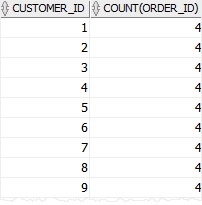
In this example, we grouped the orders by customers and used the COUNT() function to return the number of orders per group.
To get more meaningful data, you can join the orders table with the customers table as follows:
SELECT
name,
COUNT( order_id )
FROM
orders
INNER JOIN customers
USING(customer_id)
GROUP BY
name
ORDER BY
name;
Code language: SQL (Structured Query Language) (sql)Here is the result:
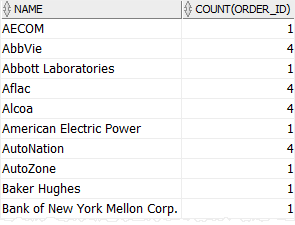
C) Oracle GROUP BY with an expression example
The following example groups the orders by year and returns the number of orders per year.
SELECT
EXTRACT(YEAR FROM order_date) YEAR,
COUNT( order_id )
FROM
orders
GROUP BY
EXTRACT(YEAR FROM order_date)
ORDER BY
YEAR;
Code language: SQL (Structured Query Language) (sql)In this example, we used the EXTRACT() function to get the year information from the order’s dates.
Unlike the previous examples, we used an expression that returns the year in the GROUP BY clause.
The following picture illustrates the result:

D) Oracle GROUP BY with WHERE clause example
This example uses the GROUP BY clause with a WHERE clause to return the number of shipped orders for every customer:
SELECT
name,
COUNT( order_id )
FROM orders
INNER JOIN customers USING(customer_id)
WHERE
status = 'Shipped'
GROUP BY
name
ORDER BY
name;Code language: SQL (Structured Query Language) (sql)Here is the output:
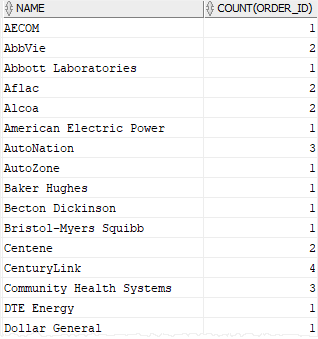
Note that the Oracle always evaluates the condition in the WHERE clause before the GROUP BY clause.
E) Oracle GROUP BY with ROLLUP example
The following statement computes the sales amount and groups them by customer_id, status, and (customer_id, status):
SELECT
customer_id,
status,
SUM( quantity * unit_price ) sales
FROM
orders
INNER JOIN order_items
USING(order_id)
GROUP BY
ROLLUP(
customer_id,
status
);
Code language: SQL (Structured Query Language) (sql)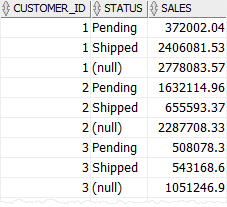
In this tutorial, you have learned how to use the Oracle GROUP BY clause to group rows into groups.